We begin with a paradox: death, the ultimate imaginative impossibility, as the creation of possibility itself. Heidegger tells us that addressing ourselves to the certainty of our own death—and therefore our own time—opens up an active engagement with the possibilities that are singularly our own,1 that the “pure essence of the possible is given in the sense of death.”2
Foucault also tells us that death creates possibility. The threat of death is the cut of the final instant that looms up like an insurmountable wall. Absolute finitude gives rise to the impulse for an infinite stalling, a way to stave off death or prolong life against this cut of death. Foucault suggests that language begins with this resistance—writing so as not to die. Death is the vertical line that prompts infinite resourcefulness, mirroring and doubling to infinity all one has said or wants to say. Against this impenetrable verticality, which reflects a thousand shards, one actively creates infinity, through a “process of amplification and thickening.”3
The endless murmuring in response to finitude that Foucault describes—thickening and doubling and mirroring, through the turns and reversals of the maze of all possible possibles—is labyrinthine rather than linear; it creates a space super-imposed upon itself, doubling again and again in the hollows of language. Furthermore, he argues that this reduplication, “even if it is concealed, constitutes its being as a work.”4 That the repetition is the work itself is important to note. Foucault proposes that a work (literature or art) exists because of this challenge and paradox it takes up, taking endlessness unto itself, and multiplying it. In its multiplication, the work creates a dwelling space for itself—and speaks of itself.
This space, “which borders death but is also poised against it,”5 is one that photography as well as language has inhabited in its ghostly way, half-demanding and assertively present, and half-retreating toward the edges of mourning and melancholy. A photograph may reflect the present back, aslant, creating angles of memory in an active construction, positioned against death, and yet limitless in the ways it is constructed, limitless in its reproduction. Foucault writes, “Headed towards death, language turns back upon itself; it encounters something like a mirror; and to stop this death which would stop it, it possesses but a single power: that of giving birth to its own image in a play of mirrors that has no limits.”6
In this essay, I will engage Foucault’s labyrinthine conception of infinity—productive, generative, reflecting back on itself—in looking at artists working with photography. Crucially, this is a different spatialization of infinity than the linear, idealized version that Heidegger warns us of—the und so weiter—which dominates our cultural mode of existence. This linear infinity idealizes by imagining the same thing, as a unit, repeating ad infinitum, rushing forward in time, relying on a hypothetical notion of self-sameness to carry it forth. It is also uniquely congruent with a capitalist trajectory. The risk in this infinite calculation of equivalences is nihilism; Heidegger describes it as the “incurable disquietude” of the absence of finalities.7 For Heidegger, the infinite has no real relevance because we are finite beings; our projections of infinite extension distract us from the actuality of finitude, which can be experienced only singularly in the mood of anxiety in relation to one’s own death. What is engaging about Foucault’s concept of infinity is that it is born in confrontation with death, rather than in denial of it, and proceeds to complicate and dimensionalize in its repetitions, rather than imagine a continuous sameness that never ends.
Repetition prompted by the anxiety of finitude—folding, amplifying, mirroring, and stalling through infinite multiplication—is characteristic of the work we will be looking at by a diverse group of artists who at first glance have no categorical similarities. Artists Martin Kippenberger, Stanya Kahn, Zoe Crosher, Tacita Dean, and Rosalind Nashashibi all create and harness the proliferation of photographs and, in their resourcefulness, turn that proliferation in upon itself and multiply it further. Like Agnès Varda in the opening sequence of her autobiographical documentary Les Plages d’Agnès (2008), they place mirrors at multiple angles to create infinite reflections. These reflections are not practical, but purposeful, “loved…as the scene, the stage, of their fate.”8
∞
Martin Kippenberger made photographs as he made paintings as he made sculptures as he made posters as he made books, so limiting our discussion only to his photographs may seem absurd. But given that his subject is by and large himself, and the photographic self-portrait still has a unique relation to the “truth of a subject,” I will focus on several of his self-portraits here. Although the indexical shadows the photographic portrait, for Kippenberger, its “veracity” is just another medium-specific substrate to be toyed with—or laughed at outright.
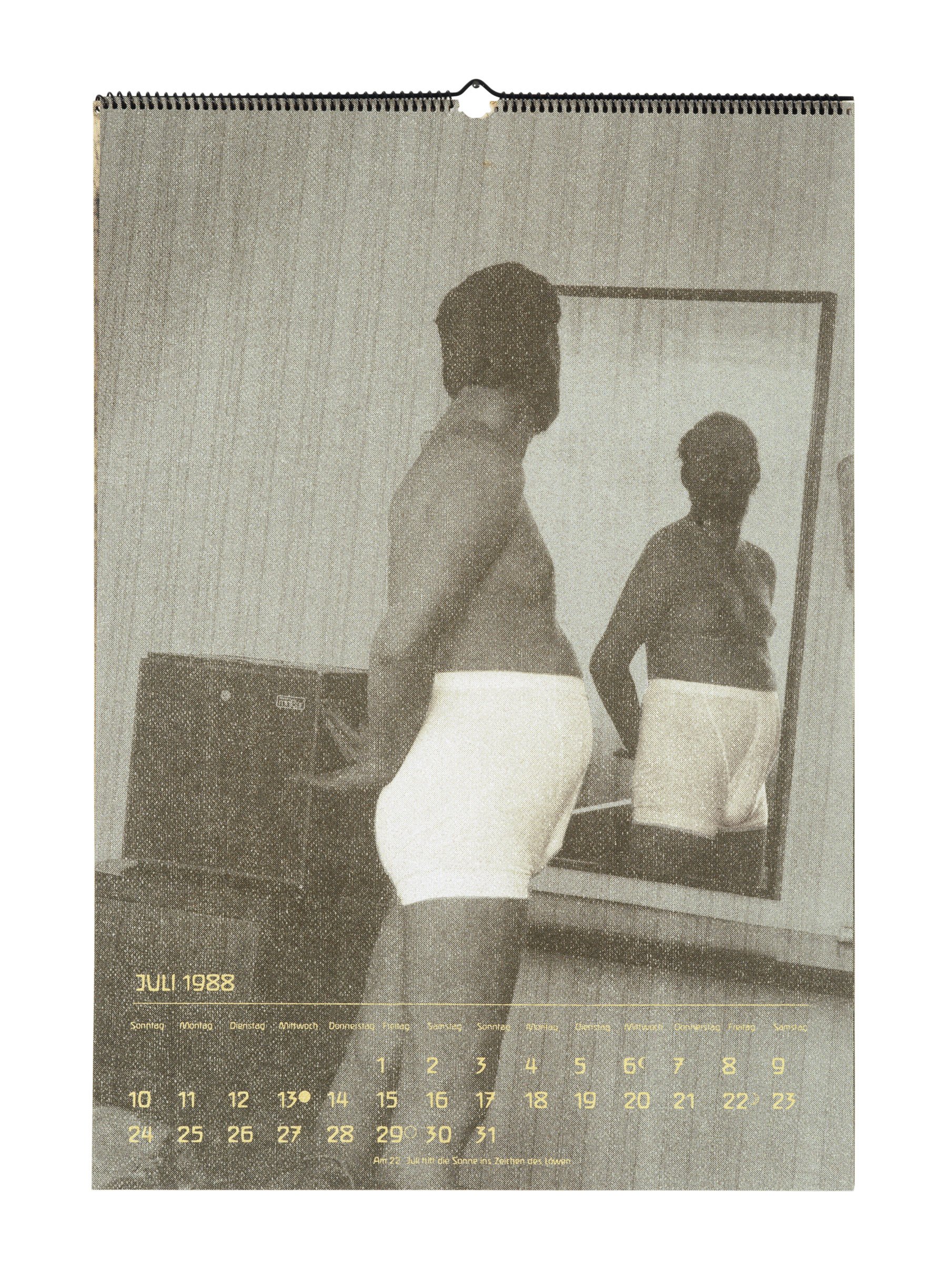
Martin Kippenberger, ELITE ’88, 1988. Calendar with 24 original silkscreens on both sides of variously colored Canson Mi-Teintes paper 160g, in slipcase; 23 3⁄4 × 16 1⁄2 inches. © Estate of Martin Kippenberger, Galerie Gisela Capitain, Cologne.
In his essay “He Who Gets Slapped,” Robert Storr writes: “From the very first we are dealing with the colossally self-conscious projection of alternately ecstatic or abject types that Kippenberger mimes rather than fully embodies.”9 Since photography itself has a mimetic relationship to the world, I highlight Storr’s use of the word mimes: to encounter Kippenberger’s photographs is to enter the realm of the mimic. He mimics other artists, and photographs repeat the trick, “mimicking” him. In his rotund and flaccid Picassos and Schnabels (“the protean Minotaur[s] gone to flab”)10 he jabs at the heroic iconography in the artist self-portrait. Gut out, white briefs hiked up to a ridiculous height, he slumps in front of a mirror to admire himself in ELITE ’88 (1988). It is a burlesque lampoon in calendar format, printed in various duotones from grey to sickly pastels. The intention of mimicry is often ridicule, but it can also be a working through. Kippenberger used his own body to occupy others, assimilate others, trying on their foibles, and amplifying them with his own.
Near the (premature) end of his life, Kippenberger made a series of portraits, photographed by his wife, Elfie Semotan, based on Théodore Géricault’s The Raft of the Medusa (1819). In the photographs, Kippenberger performs symbolic poses from the painting, the weight of the art historical canon inscribed in his figure (Kippenberger reenacts Géricault; Géricault echoes Michelangelo’s Last Judgement), calling up the drama in extreme fatigue. His is a weighty presence—body corpulent, face lined, “bloated and haggard, a big sick baby, a wreck.”11 The pathos is both real and absurd (he’s draped over his bed, naked but wearing dark socks) and we are seduced, but in a way that leaves us holding the bag: aware of both the seduction and its set-up.
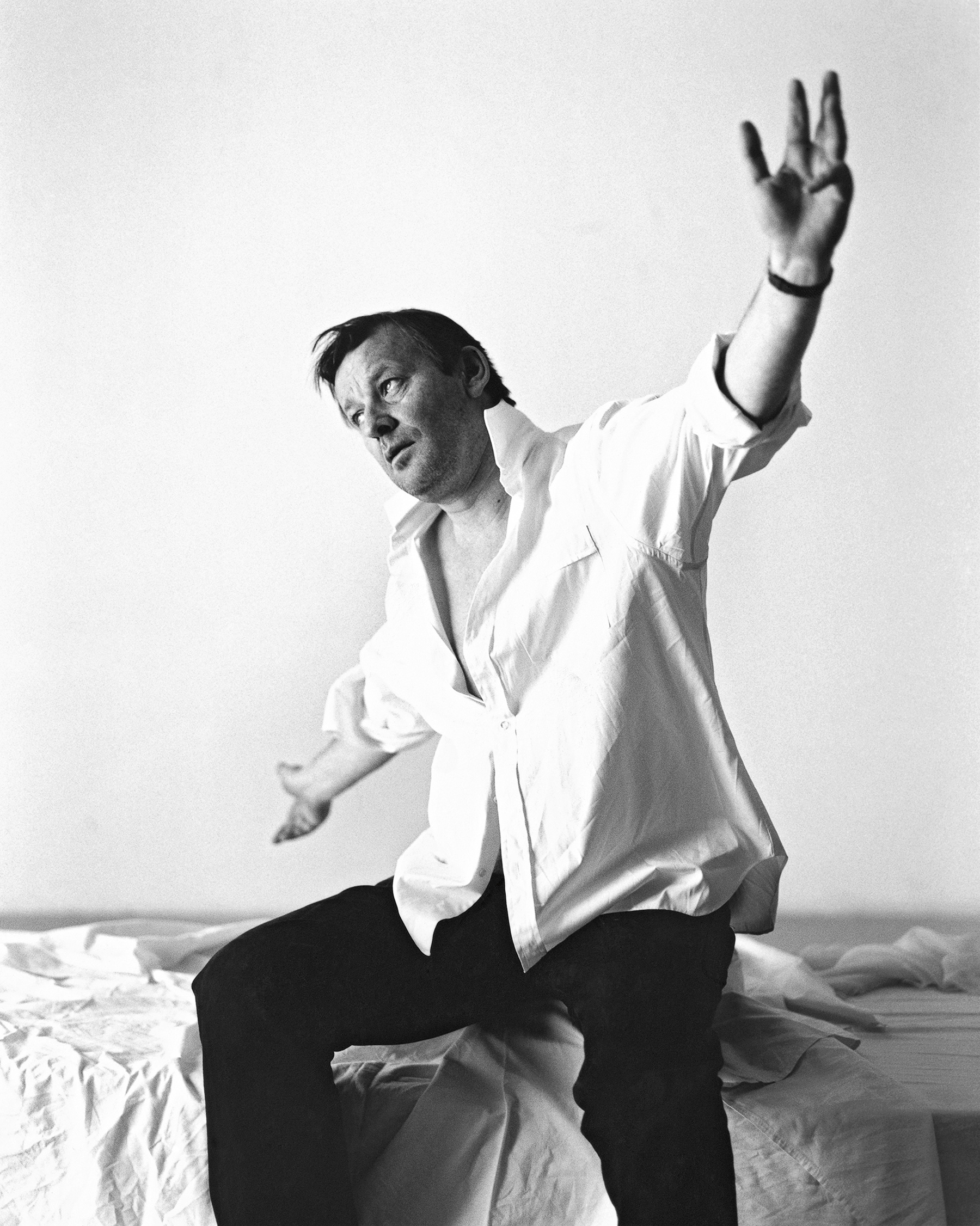
Martin Kippenberger in his studio posing for the series Das Floß der Medusa (The Raft of the Medusa), Vienna, 1996. Photos by Elfie Semotan. © Elfie Semotan.
We recall here Camus writing of Don Juan: “He is an ordinary seducer. Except for the difference that he is conscious, and that is why he is absurd.”12 Kippenberger was a conscious maker; he knew what tropes he was miming and to what effect. His takedowns (of himself, of other artists) were always imbued with the oft-masked effort of trying to build oneself up, that “useless attempt, that ineffectual persistence.”13 Yet, as Storr puts it, he was a “cynic who never breaks character.”14 Kippenberger was driven by these useless attempts, both the angler of the mirror and the subject running in front to be reflected in it. He dramatized the extremities of self-aggrandizement one typically tries to repress. The shamelessness of self-promotion (a mania of showing oneself to be an artist), coupled with actual shame, were his raw materials. And he was prodigious, working fast, “beyond the bogus authority of genre, taste and style,”15 moving on. In The Myth of Sisyphus, Camus says, “By miming man as he can be and as he is, the actor has much in common with that other absurd individual, the traveler. Like him, he drains something, and is constantly on the move.”16 In the total focus on the self in Kippenberger’s oeuvre, we yet feel his insistence on a self on the move—on excessiveness, overabundance, on a multiplicity that evades the veracity of any single version of the self. Storr says that Kippenberger “hams it up not to draw us close to his true self but to direct our attention away from the very possibility that such a self exists within the hall of mirrors that multiply and distort his image.”17 This is an excessive and also evasive impulse, as Camus describes Don Juan “applying himself wholeheartedly to being nothing or being several.”18 “Ja ja ja,” Kippenberger booms, mimicking Beuys in a sound piece.19 “Nee nee nee!” In both resigned agreement and exuberant refusal, Kippenberger is yes and no at once.
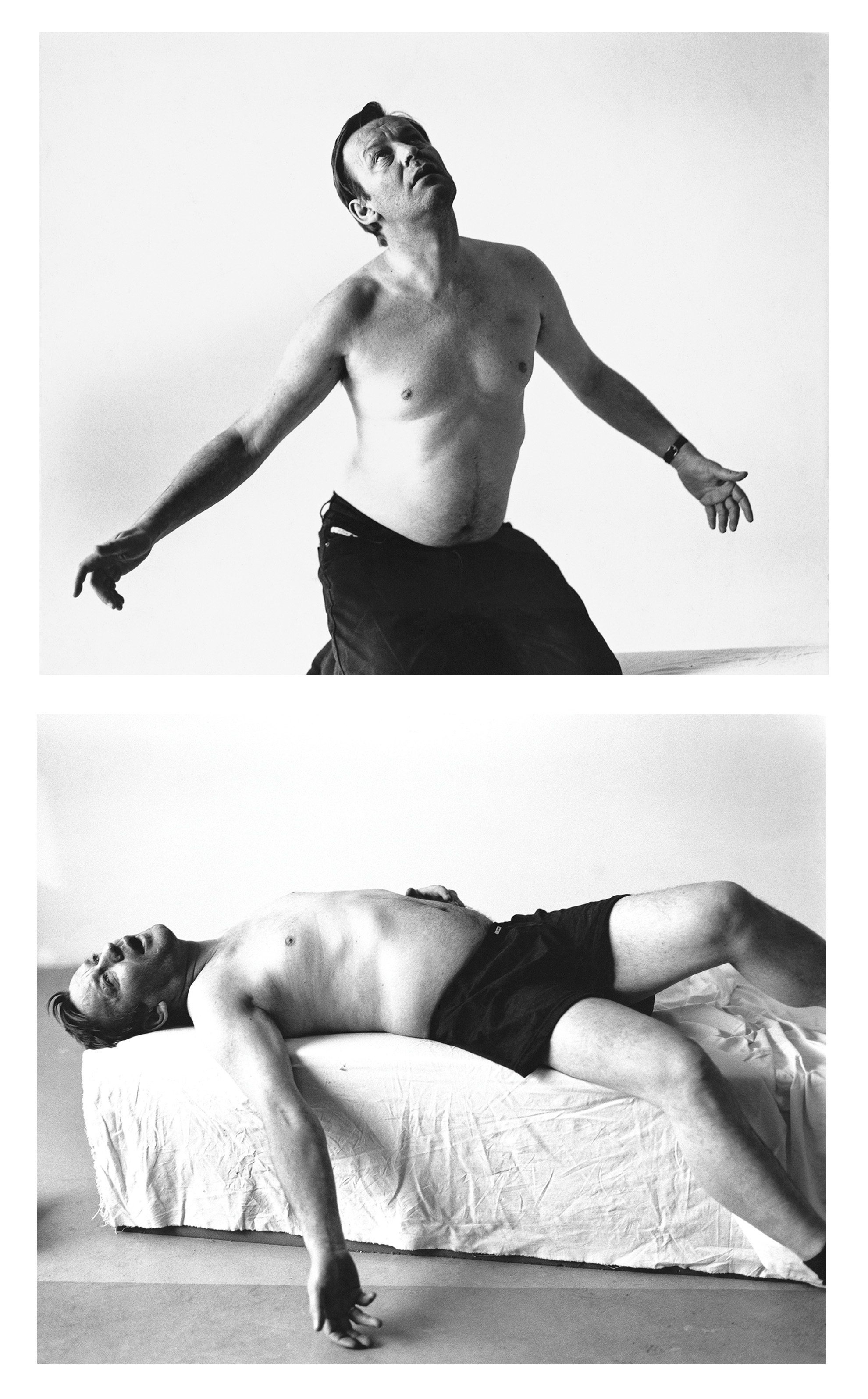
Martin Kippenberger in his studio posing for the series Das Floß der Medusa (The Raft of the Medusa), Vienna, 1996. Photos by Elfie Semotan. © Elfie Semotan.
Looking back at the wake of his production, one feels the manic anxiety and force of the “fast-make fast-take.” We know that everything will become systematized in retrospect. Yet to ignore this and remain a dramatist—this is the challenge Kippenberger performed, conscious of limits while enacting their absurdity—a player in infinite play.20
Storr writes of Kippenberger, “The anti-mystical, anti-macho jack-of-all-trades used his ready-made disguise to perform, indeed promote defeat and humiliation.” In a photograph taken of a bandaged Kippenberger in the hospital (after he was beaten for raising the price of beer in his bar S.O. 36), he is in a “ludicrous headdress” and next to a stuffed frog. Similarly, in Stanya Kahn’s video It’s Cool, I’m Good (2010), the main character, played by Kahn, wears a hospital gown and bandages that bind what appear to be devastating injuries. Released from the hospital despite being visibly mangled, she ambles around chatting with strangers on the streets of Los Angeles and attempting the archetypal activities of a California native—skateboarding, dirt-biking in the desert—hospital gown untied, ass to the wind.
We don’t know whether she is dying or recovering,21 and this question marks the now as an uncertainty: either a now that is opening up, or a now that is disappearing. But Kahn assures us that she is fine. She asks questions, tells terrible jokes. The tape (which appears to be Scotch tape) on her nose oozes. And we scrutinize it, and her, wondering what the infection and the joke really is.
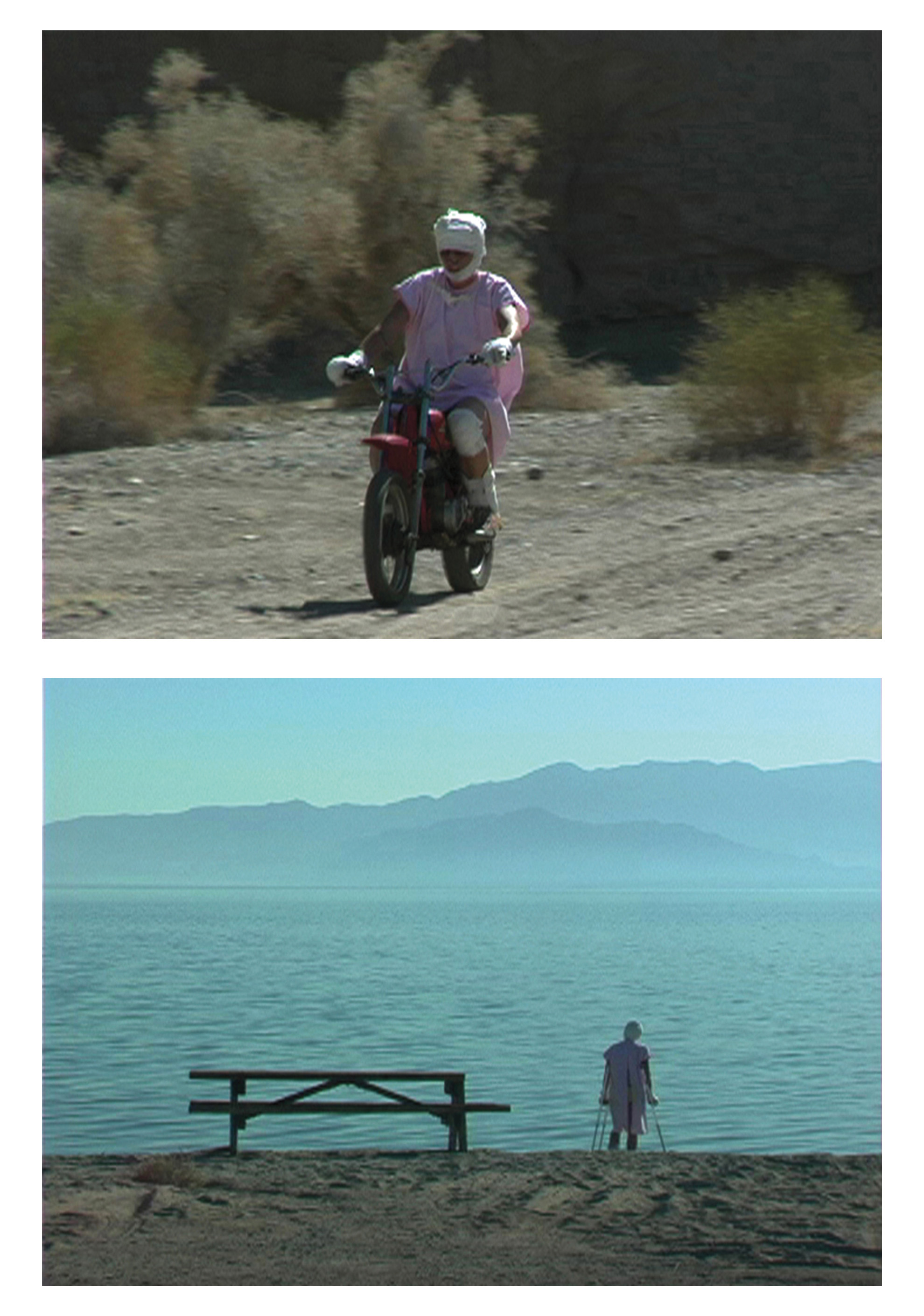
Stanya Kahn, Video stills from It’s Cool, I’m Good, 2010. Single-channel color video with 5.1 surround sound, 35 minutes 22 seconds. Courtesy of the artist and Susanne Vielmetter Los Angeles Projects.
During moments of critical injury, life rears up more palpably, and the unending infinite that we delude ourselves with daily seems indeed like a joke. Kahn makes use of this existentially compact time and drags it into a sustain, elongating the moments of a near-death injury into the ongoing everyday moments of a normal life. Her extension of this span of time allows anxiety to work its angles, like Borges’s Hladik before the firing squad, extending a second to last for a year.22
I have been speaking of still photographs, yet Kahn’s extension materializes through video, and this movement is critical, urgent. Urgency (a la “urgent care”) becomes ontological. Kahn needs to speak, to act, to move; death is stasis, motion a marker of a body alive. Working with the repetition not of photographs, but of video frames, Kahn complicates this specific time (the time of imminent disappearance) in the most comic and contradictory of ways—preparing for it, denying it, improvising in it. As Kahn puts it: “deterioration is still full of action.” By densifying the experience in labyrinthine time—détournements both ridiculous and serious—she expands that time, amplifying it and thickening it, a literal embodiment of Camus’s “distressing nudity”23 of the absurd.
∞
Zoe Crosher is Michelle DuBois. Or Michelle DuBois is Zoe Crosher. Or neither is neither or both are both. For almost a decade, Crosher has been working with DuBois’s archive of self-portraits in “a method of multiplication [and] continual reiteration”24; she has arranged and rearranged, assembled and reassembled the photographs into groupings, books, and exhibitions, under evolving titles such as The Reconsidered Archive of Michelle DuBois (2004–8), The Disappearance of Michelle DuBois (2011–13), The Disbanding of Michelle DuBois (2013–14), etc.
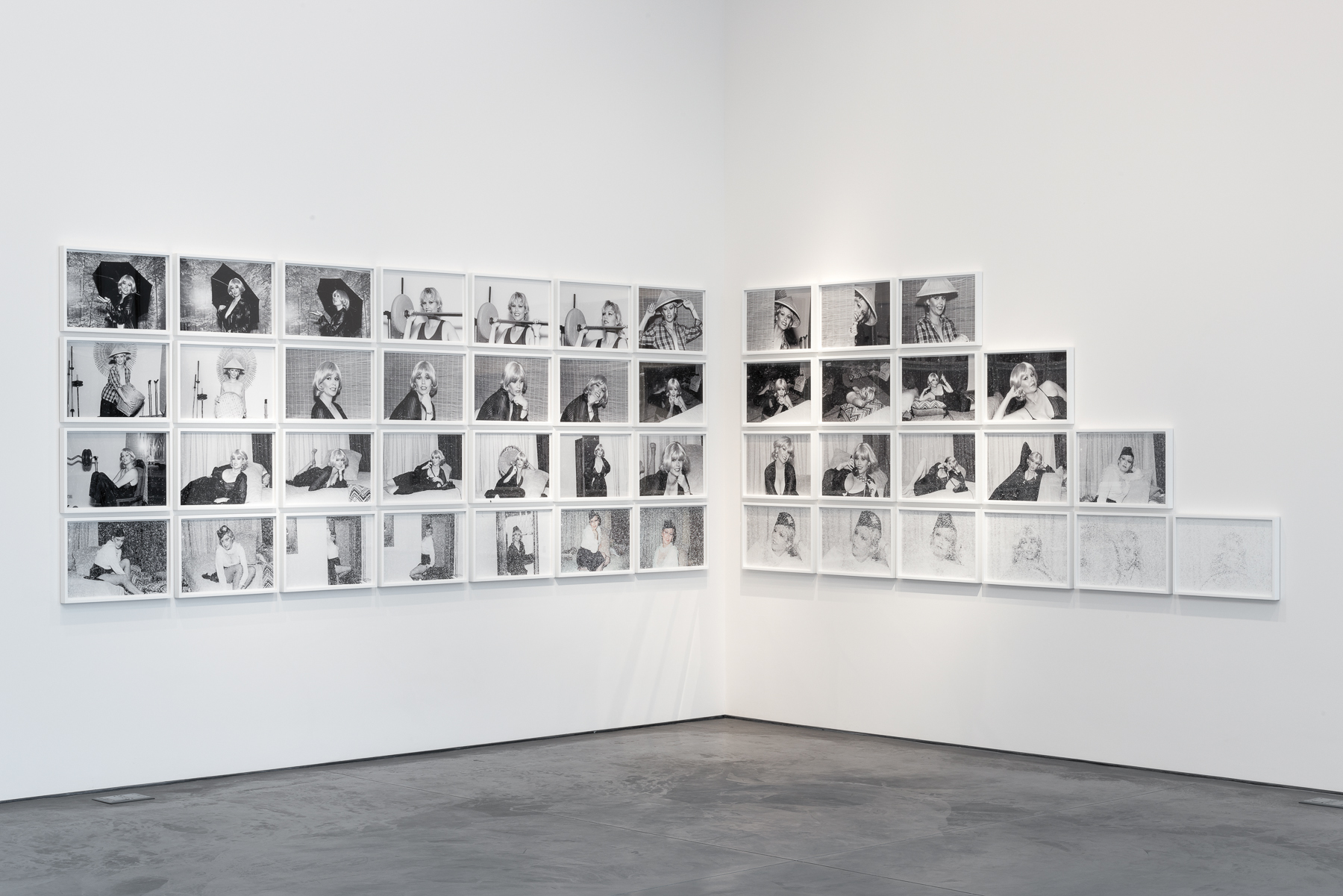
Zoe Crosher, No.1–46 from The Additive Dust Series (GUAM 1979) from The Disappearance of Michelle duBois, 2012. 46 Archival pigment prints mounted on Dibond, 13 × 19 inches each. Edition 1 of 6. Image courtesy of the artist and Perry Rubenstein Gallery, Los Angeles. © Zoe Crosher. Photo: Joshua White/JWPictures.com.
In thousands of photographs, DuBois animates herself within a dead corpus, those gestures and poses of femininity we all know (the head tilt, the coy side-smile, the ass-out)—dead until she repeatedly inhabits them. Sometimes she is dead within them too, but there’s always something—a glint from an errant reflection that reveals something unwanted, a lock of wig gone wrong, a dirty soap dish behind the sexy bubbles—that is alive in the image.
Crosher speaks of DuBois’s process: “I realized she functions under a perpetual present. So for her there’s always another photograph because she’s on this perpetual level of re-living, which is a very exciting space but also a very anxious space. She’s not unhappy but there’s an anxiety to it, it’s very compulsive.”25 Here our moment’s most compulsive form of the self-portrait comes to mind: the “selfie,”26 which we currently experience via Facebook, Instagram, Tumblr, etc. The desire to be seen in this digital vein of self-portraiture also holds an anxiety, perhaps an ontological one: the distinct feeling of the possibility of a world without me (the possibility of my not-Being-in-the-world). In the face of this threat, one serves a compulsion to repeatedly project images of oneself onto the screen of the world. But in the anxious speed of filling a screen, the instantaneous does not pause to consider. One moves on to what is next: the scroll, the Heideggerian und so weiter as an infinite stream of images.
The way Crosher displays this project complicates this kind of linear infinity. She re-presents DuBois’s photographs in simultaneity and repetition, bringing a fullness and expansion to a single moment. Crosher finds possibilities in the photograph’s “own division…its own repetition, the power to create a vertical system of mirrors, self images, analogies.”27 If we consider the photograph in the ways Foucault speaks of language (as if struck from within by a disease of proliferation; it is always beyond the limit in relation to itself; it only speaks of a supplement starting from a displacement,”28) then we see the perpetual need for another photograph: the absence at its core. The self-portrait is a supplement in that it adds something to our perception of ourselves (fantasy, distantiation, etc); it is a displacement in that the image is of course not the person; this excess and deficiency are simultaneously at play in Crosher’s work, in the constant re-working of subjectivities.
Crosher plays with DuBois’s excessive archive, manipulating, refracting and reflecting on it further, making groupings or multiples. These multiples are considered versions of the excessive. Crosher considers the excessive and asks us to consider it; in this reflection we recognize some form of our own anxiety. It is a meta-reflection of the excessive, a signifier of the infinite, that speaks about anxiety instead of from within its grip. In this Crosher enters the DuBois archive into the discussion about what photography is and is not capable of, and Crosher seems to be aware of this in a way that DuBois is not. But both assert their own roles as producers and disseminators of representations. As Mae West said: “A dame that knows the ropes isn’t likely to get tied up.”
∞
I have been speaking of anxiety in direct confrontation with mortality, but a variant of the term that is used, and medicated for, most frequently today is free-floating anxiety. A Freudian “anxiety-neurosis” speaks of an un-anchored sense of loss or dispersion (versus fear, which has its specific object). This anxiety is defensive (an inwardly directed form of vigilance)29—a signal that prompts preservation, as the ego attempts to integrate its energies by amassing and archiving. The term Freud uses is binding: “the tendency to unity, which is particularly characteristic of the ego.”30 Photography is a suitable medium for this binding, or preservation. The photograph preserves loss; in it, the past stays sealed and ready to proliferate as past into the present. The repetition of the past-as-past is a wish to extend a prior state into the future as is; it is a kind of traumatic use of photography. But repetition as Foucault describes it is not a self-same repetition; rather, it performs an almost hidden revelation of our struggle as dramatic players, poised against death. In the malleability and multiplicity of our retelling, another language is born, escaping a certain trajectory toward death, released from a one-to-one relation with reality. With this comes the surprise of the past being at once past, truly present, and turned toward the future, and thus open to manipulation and reinterpretation. Repetition begins each moment anew, referring to itself in both backward and forward motion, expanding our experience of that moment.
Tacita Dean’s Floh (2001) is a book compiled using found photographs in European and American flea markets. (Floh is German for flea.) One has the sense of an archive being compiled, but the flow of the images does not give a linear nor historically consistent narrative or a sense that this is a project that might ever be completed. One only has a sense of the found as one flips through its pages. In a flea market, objects have been uprooted from their origins. Dislocated and now freely circulating, the photographs one finds in a flea market have been removed from their previous contexts. Because they are family photographs, we assume that these are the loved, the seen to be loved, but for this the photographs need the family members to complete the loop. They were taken of, for, and by the same group of people. But that tautology has been ruptured; these photographs have lost those who loved them.
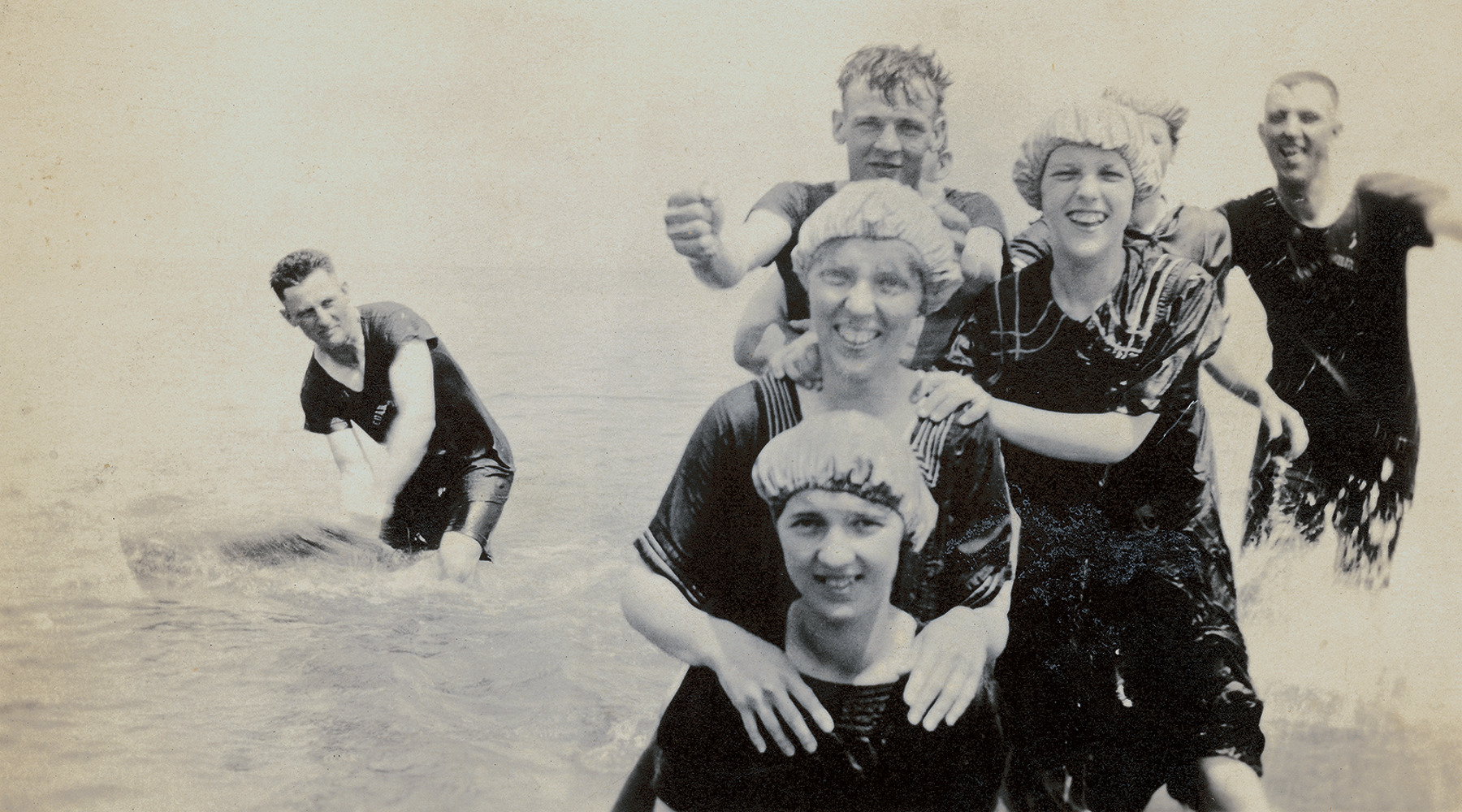
Tacita Dean, Image from Floh, 2001. Courtesy the artist, Frith Street Gallery, London, and Marian Goodman Gallery, New York/Paris.
The connections made in Floh are made through folds in time. The spreads in the book create unexpected diptychs: on the left, a Polaroid of a woman pulling red yarn through her crochet, on the right, a daguerreotype of a matron in black silk dress, hair greased down, about to pull a different thread. In another image: bathers in the sea. They are wearing what appear to be shower caps; seawater drenches their black wool swimsuits, which cover their entire torsos, men and women. It is not only the lives of the bathers depicted in the photograph that holds us, but that they do not know us. Each bather squints against the grey faded glare of the sun, presumably toward another wet, black-suited swimmer, who is holding a camera. Their gaze is intended for another, as are their smiles and playful shoving of seawater toward one another. In the photographs in Floh, people gaze—each with a different frozen glance, each unique, each more or less pointing to the same spot—toward a photographer who is now gone. But now it is you, the viewer, who has met this gaze, you, unknown to them, you, unknown to this moment.
There are 4,000 signed copies of Floh in the world. Tacita Dean imagines that editions of the book might, over time, make their way into antiquarian bookshops, and even perhaps flea markets, as the owners of Floh themselves disappear. Photographs continue to exist, although they point toward the disappearance that all living things face. Made of slightly more durable material, photographs (and books) decompose at different rates than the living. We clone ourselves in this paper, put our resistance to the ends of things in this transference of materiality, and also in the hands of other people who might transfer this material into other hands, and so on and so forth. The book itself is meant to proliferate, to repeat itself in the hands of strangers.
Floh has no texts or captions. It is the proliferation of photographs—both mechanically, in the printing of the book, and visually, in the proliferation of the seen—that has the rush of ontological signification, the telling of itself (the wiles and intrigue31 of warding off death). If these photographs are indeed obsolete—purposeless to render their original significance—then Dean’s project is to collect and perpetuate this obsolescence, re-order it, multiply it, and send it forth—mutating it by simultaneously following the movement of its past and its as yet unimagined future.
Writes Benjamin: “Every passion is chaotic, but the collector’s passion borders on the chaos of memories.”32 Floh triggers this chaos of looking and remembering (as a vaccination may bring about a rush of initial fever as the body recognizes the disease). The infiltration of these disembodied memories into another host further complicates the state of remembering, since these are not your memories (“each person is made up of thousands of other people”33) but instead are presented as the chatter of memory making itself. Dean puts the idea of memory into the present and future tense.
∞
How can a painted face be the same as a face painted? How does a fist outstretched differ from a fist at rest? A shelter, a tundra. This bed and another bed. Photography tells things apart. It puts things not in proximity in proximity, like language. (Here, a tundra.) In a book, pages are proximities, like frames in a film. Rosalind Nashashibi makes films. And like her films, her book Proximity Machine (2007) puts far things close, puts resemblances close, and slows them down. The time of looking becomes the magma of stupidity. A lump of coal, a meteorite? This face painted like that. We know, of course, that photographs prompt this stupidity all the time, looking without knowing, the jumble of one page after the next. Dissonance in proximity is our contemporary experience of the world. So what do we make of this avalanche of proximity? Proximity Machine makes something of it. The pages are slippery like a magazine.
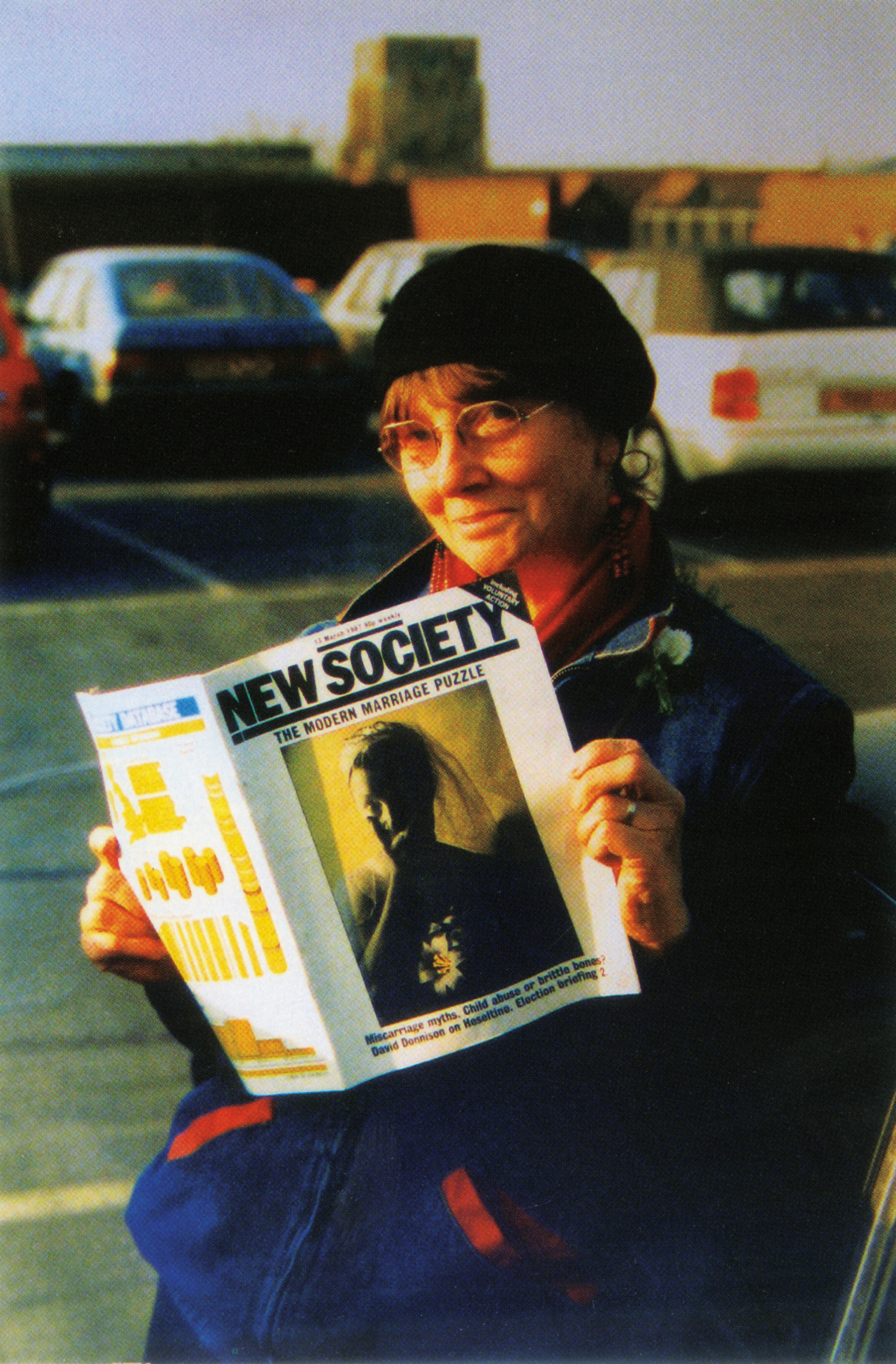
Sequence One in Proximity Machine, by Rosalind Nashashibi, published by Book Works, 2007. Image: invite card to an exhibition at Street Level, Glasgow, featuring Jo Spence holding a copy of The New Society.
Nashashibi describes the book as having “a lot of the mess and remainder”34 of the process of making it and trying to follow it. To compile the images that make up Proximity Machine, she looked through books with no system except browsing and photocopying. She spent a year sequencing the images. The book is numbered, as if in chapters. She says that the numbers help readers to feel that they are getting somewhere—from 1 to 10—“even though it’s kind of ridiculous.”
Just as Dean complicates the typically sequential family album with Floh, Nashashibi’s Proximity Machine also confronts the problem of linearity, so one has to look longer, or move forward and backward through the sequence of pages to find hidden structures and connections. “I think about the different speeds of linearity,” Nashashibi says, “and how there’s only certain moments within that when you become aware of the passage of time, and other times when you’re not.” A moment can dilate and contract with looking. Spans of time can pass inconsequentially, meaninglessly, while gazing, or they can be filled with connections and triggers. Individual time is variable and therefore the time of our looking is variable. Proximity Machine demonstrates and materializes this kind of variegated time.
Because Proximity Machine has almost no text, and the photographs are so varied upon first glance, you spend time flipping, trying to make linkages from the references visually available to you. Whether or not you catch that the first image of the first section is a photograph of Jo Spence that was made as a card for her exhibition at Photoworks in Edinburgh in 2005, or that the second image is Spence’s photograph, entitled The History Lesson—Revisualization (1982), you may at least read at first glance two images of people holding reading material. You cannot possibly fail to see the googly-eyed glasses on the man reading Freud on Sexuality in the second image. These eyeballs echo Freud’s perfectly round glasses, which echo the larger circles of cement pipes in the background. As you look, connections other than formal ones jump out: Spence holds a magazine with a cover story on marriage, the man holds a book with sex as its subject. The third image, a photograph on a laminated Japanese menu cover, looks like a concrete face; we cannot help but read it anthropomorphically because of the visual resonances from the previous image. Our propensity for anthropomorphism then echoes other works in Nashashibi’s own practice (specifically, her film Eyeballing [2005]).
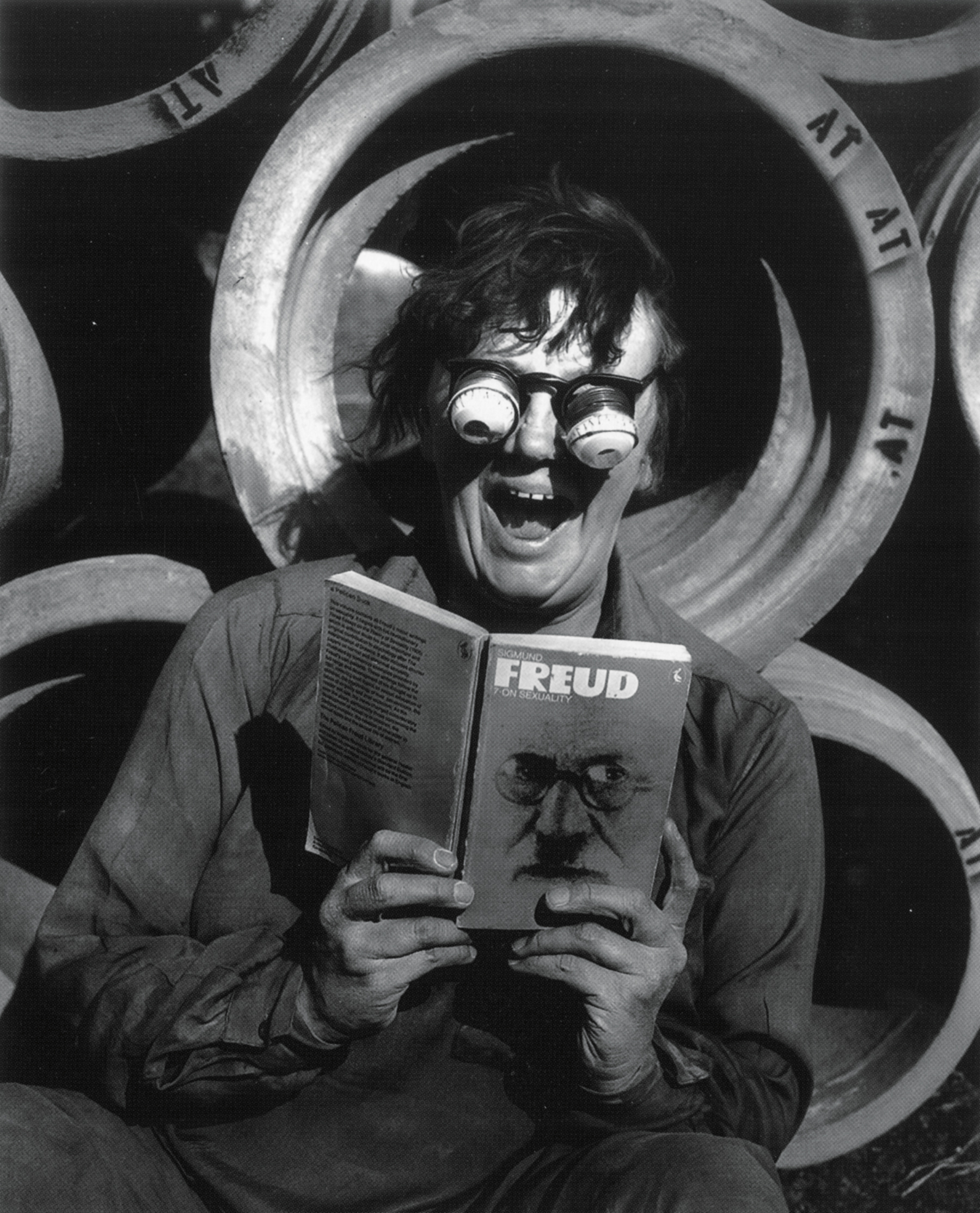
Sequence One in Proximity Machine, by Rosalind Nashashibi, published by Book Works, 2007. Image: The History Lesson—Revisualisation, by Jo Spence/Terry Dennett, 1982, from Cultural Sniping: The Art of Transgression, Jo Spence, Routledge, London & New York, 1995, page 80.
In looking fast or in looking slow, in moving forward or backward or both, a reader can begin to discern that each chapter in Proximity Machine has an internal logic, as does the book as a whole. It is proximity that creates the logic. Nashashibi, who has an affinity for the analogue, likens her book to a car engine, the friction of images causing one explosion to lead to the next. But it is not the photographs that lead one to the next (that would be truly anthropomorphizing); it is Nashashibi who does. She selects and arranges. It was her choice to reproduce images only from books or printed matter, her choice, method by association. Because this method is a kind of synthetic proposition, each connection between images contains the possibility for all images to be “next,” the weight of all possible possibles.
This is a ponderable concept: all possible possibles, the un-calculable infinite. Many people imagine the infinite linearly: for example, via numbers (i.e., counting with no end). Although it’s a slim volume, Proximity Machine gives one a sense of this linear infinite, but in rearrangement. For example, when one notices a connection within the book, such as people holding pieces of the cosmos,35 one is struck by the distance in time and space this juxtaposition brings into proximity. It rearranges diachronic, linear time, making synchronous connections and reflections, both encouraging and disturbing our tendency toward resemblance.
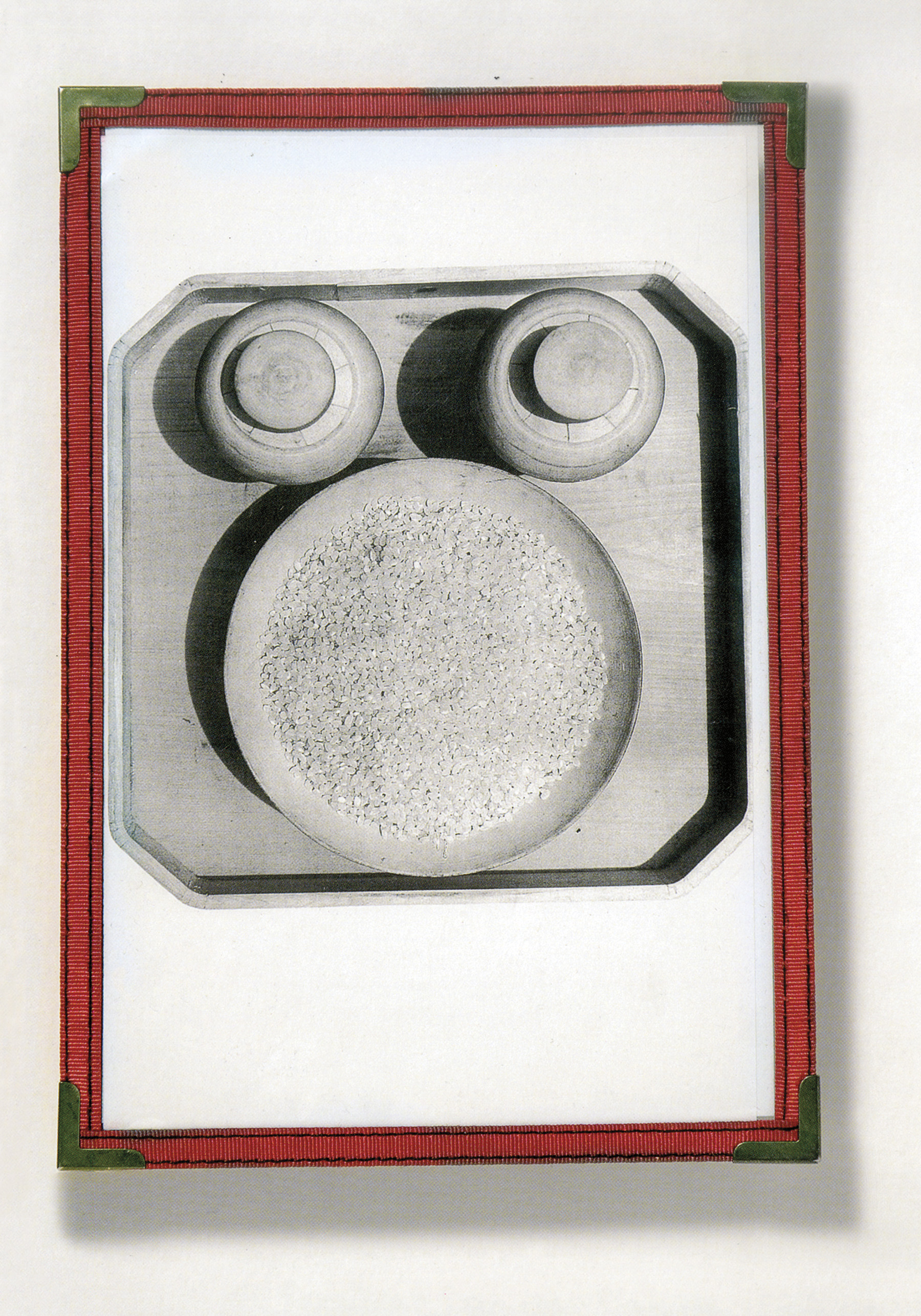
Sequence One in Proximity Machine, by Rosalind Nashashibi, published by Book Works, 2007. Image: Saki Menu Cover from 2005, Restaurant Jewel Bako Makimono, New York.
Craig Owens posits that the mirror first started appearing in photographs as “photography began to depict its own possibilities and conditions in its images.”36 His seminal essay “Photography en abyme” describes a condition where reduplication from within a photograph begins to tell “what a photograph is”37 through the depiction of mirrors or reflective surfaces within its frame, or through doubling and cropping within the image. These multiple reduplications speak of the “network of internal relations between subject, mirror, and other, which structures the image.”38 Tracing Gide’s and Derrida’s literary modes, which define en abyme as “any fragment of a text that reproduces in miniature the structure of the text in its entirety,”39 Owens adds the photograph to this tradition, describing, for example, the infinite interplay within the photographs of Brassaï. Rather than all duplications leading back to “an original” (the object, and not its layered representations), Owens proposes a theory of the abyss—made of an infinite chain of interpretations that forever reaches inside of itself, without an original. One could make the argument that this abyss, this en abyme, is an echo from Foucault’s essay Language to Infinity.40
But instead of an internal reduplication within the confines of a single image, Nashashibi angles the mirror outward, outside the frame of a single photograph. Her reduplicating connections don’t double and fold inward, reproducing in miniature the structure of the photograph as a whole. Rather, they reverberate outward, seeking their reflections in other images. This is a messier game than the tight structure of a photograph en abyme and its satisfying visual multiplication and self-reflexivity regarding the medium. The borders and boundaries of construction and meaning are porous in Nashashibi’s choice of photographs, leading ever outward. There is always another photograph, and one can imagine there will be, to infinity. Proximity Machine confronts our anxiety in the infinite choice of possible photographs. To return to our starting point, for Heidegger, anxiety comes in relation to the infinite because we as humans are finite beings, and endlessness can become meaningless. But through making subtle, sometimes personal linkages between disparate images, Nashashibi moves us forward and backward in time, trying to confront the sense of this infinite extension with our human need to form meaningful connections; this takes remembering as well as projecting.
Nashashibi says that she doesn’t know when she’s making her work “whether there will be something or nothing. That sort of anxiety is really necessary for me.” What engages us in this book is precisely this risk.
∞
It is as if the last were not the last for there is a last laster than the last, without taking into account the lastests of the last…
–Hélène Cixous41
Anxiety puts us in confrontation with death. Anxiety knows: “What anxiety knows of death is that it is imminent—the last instant may be the next instant—and that is for me, impotence in existence. Anxiety is the premonition…of the pure menace of the instant that would be the last instant.”42 And so it is the expansion of the instant (through refraction, multiplication, densification, complication, excessiveness)—rather than the preservation of the instant that photography is so often predisposed to—that has been my preoccupation in this essay.
In a time when the expectation of ongoing production is the norm, Heidegger’s concept of anxiety and Foucault’s labyrinthine production of infinity provide openings for more anxious, complex, and urgent gestures in art via repetition. Against the und so weiter of daily existence—empty repetitions that idealize and extend a nostalgic past—these works create a different temporal emphasis for the photograph. The extension or opening up of time allows anxiety to produce its infinite effects: in improvisation, invention, in stalling, in feints—which appear to us as photographs, inscribed with the effort to extend time long enough to tell the story, and to tell of telling itself.
Kim Schoen is an artist and writer. She received her MFA from CalArts in 2005 and her Masters in Philosophy from the Photography Department of the Royal College of Art in 2008. Her photographs and video installations have been most recently seen in Unsparing Quality (Diane Rosenstein, Los Angeles) and Stupidious (South London Gallery, London). This is her third essay on repetition and photography; the first: “The Serial Attitude Redux,” was published in X-TRA, vol. 12, no. 2 (winter 2009). Schoen is also the co-founder and editor of MATERIAL, a journal of texts by visual artists.
